Macroeconomics
Chamberlain College Of Nursing
All 20 results
Sort by
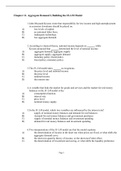
-
Chapter 11. Aggregate Demand I, Building the IS-LM Model.
- Exam (elaborations) • 32 pages • 2022
-
- $7.49
- + learn more
Chapter 11. Aggregate Demand I, Building the IS-LM Model 1.John Maynard Keynes wrote that responsibility for low income and high unemployment in economic downturns should be placed on: A) low levels of capital. B) an untrained labor force. C) inadequate technology. D) low aggregate demand. 2.According to classical theory, national income depends on , while Keynes proposed that determined the level of...
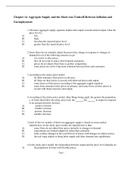
-
Chapter 14. Aggregate Supply and the Short-run Tradeoff Between Inflation and Unemployment
- Exam (elaborations) • 30 pages • 2022
-
- $7.49
- + learn more
Chapter 14. Aggregate Supply and the Short-run Tradeoff Between Inflation and Unemployment 1.The basic aggregate supply equation implies that output exceeds natural output when the price level is: A) low. B) high. C) less than the expected price level. D) greater than the expected price level. 2.Some firms do not instantly adjust the prices they charge in response to changes in demand for all of the following reasons except: ...
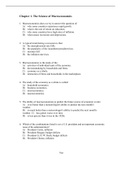
-
Chapter 1. The Science of Macroeconomics
- Exam (elaborations) • 13 pages • 2022
-
- Free
- 1x sold
- + learn more
Chapter 1. The Science of Macroeconomics 1. Macroeconomics does not try to answer the question of: A) why some countries experience rapid growth. B) what is the rate of return on education. C) why some countries have high rates of inflation. D) what causes recessions and depressions. 2. A typical trend during a recession is that: A) the unemployment rate falls. B) the popularity of the incumbent president rises. C) incomes fall. D) the inflation rate rises. 3...
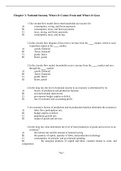
-
Chapter 3. National Income, Where It Comes From and Where It Goes
- Exam (elaborations) • 44 pages • 2022
-
- $7.49
- + learn more
Chapter 3. National Income, Where It Comes From and Where It Goes 1.The circular flow model shows that households use income for: A) consumption, saving, and factor payments. B) consumption, taxes, and factor payments. C) taxes, saving, and factor payments. D) consumption, taxes, and saving. 2.In the circular flow diagram, firms receive revenue from the market, which is used to purchase inputs in the market...
Chapter 5. Inflation, Its Causes, Effects, and Social Costs
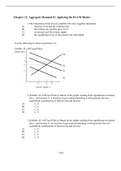
-
Chapter 12. Aggregate Demand II, Applying the IS-LM Model
- Exam (elaborations) • 39 pages • 2022
-
- $5.89
- + learn more
Chapter 12. Aggregate Demand II: Applying the IS-LM Model 1.The interaction of the IS curve and the LM curve together determine: A) the price level and the inflation rate. B) the interest rate and the price level. C) investment and the money supply. D) the equilibrium level of the interest rate and output. Use the following to answer questions 2-4: Exhibit: IS–LM Fiscal Policy 2.(Exhi...
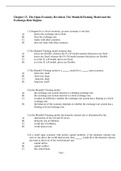
-
Chapter 13. The Open Economy Revisited, The Mundell-Fleming Model and the Exchange-Rate Regime
- Exam (elaborations) • 36 pages • 2022
-
- $6.59
- + learn more
Chapter 13. The Open Economy Revisited, The Mundell-Fleming Model and the Exchange-Rate Regime 1.Compared to a closed economy, an open economy is one that: A) allows the exchange rate to float. B) fixes the exchange rate. C) trades with other countries. D) does not trade with other countries. 2.The Mundell–Fleming model assumes that: A) prices are flexible, whereas the IS–LM model assumes that pri...
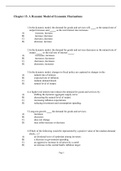
-
Chapter 15. A Dynamic Model of Economic Fluctuations
- Exam (elaborations) • 27 pages • 2022
-
- $7.49
- + learn more
Chapter 15. A Dynamic Model of Economic Fluctuations 1.In the dynamic model, the demand for goods and services will as the natural rate of output increases and as the real interest rate increases. A) increase; increase B) increase; decrease C) decrease; decrease D) decrease; increase 2.In the dynamic model, the demand for goods and services decreases as the natural rate of output or the re...

-
Chapter 16. Understanding Consumer Behavior
- Exam (elaborations) • 29 pages • 2022
-
- $6.29
- + learn more
Chapter 16. Understanding Consumer Behavior 1.The consumption decisions of individuals are not important for the: A) determination of the steady-state capital stock. B) determination of fiscal-policy multipliers. C) determination of aggregate demand. D) determination of sticky prices. 2.The marginal propensity to consume is the: A) ratio of consumption to income. B) amount consumed out of an add...
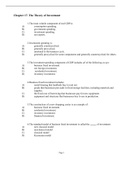
-
Chapter 17. The Theory of Investment
- Exam (elaborations) • 26 pages • 2022
-
- $7.49
- + learn more
Chapter 17. The Theory of Investment 1.The most volatile component of real GDP is: A) consumption spending. B) government spending. C) investment spending. D) net exports. 2.Investment spending is: A) generally countercyclical. B) generally procyclical. C) unrelated to the business cycle. D) generally procyclical for some components and generally countercyclical for...

That summary you just bought made someone very happy. Also get paid weekly? Sell your study resources on Stuvia! Discover all about earning on Stuvia



